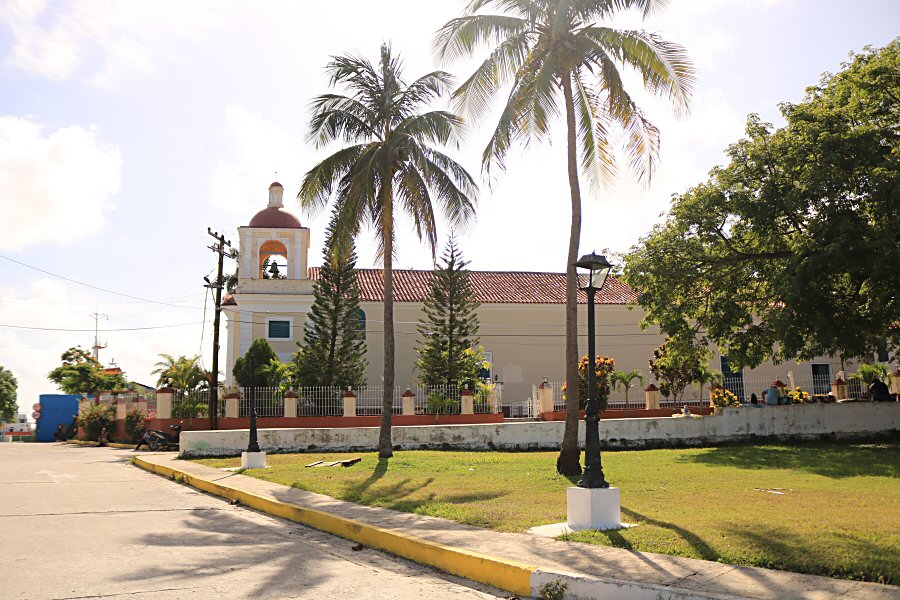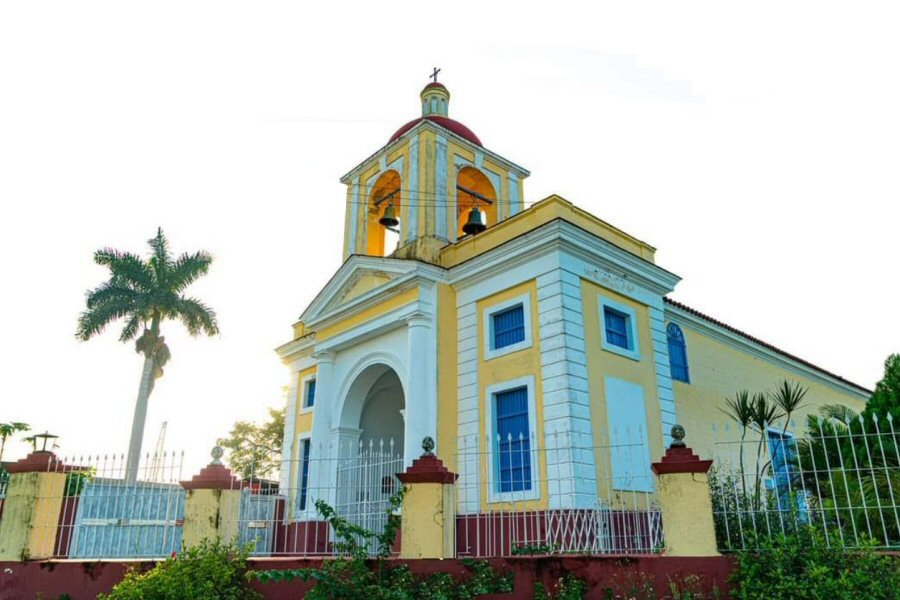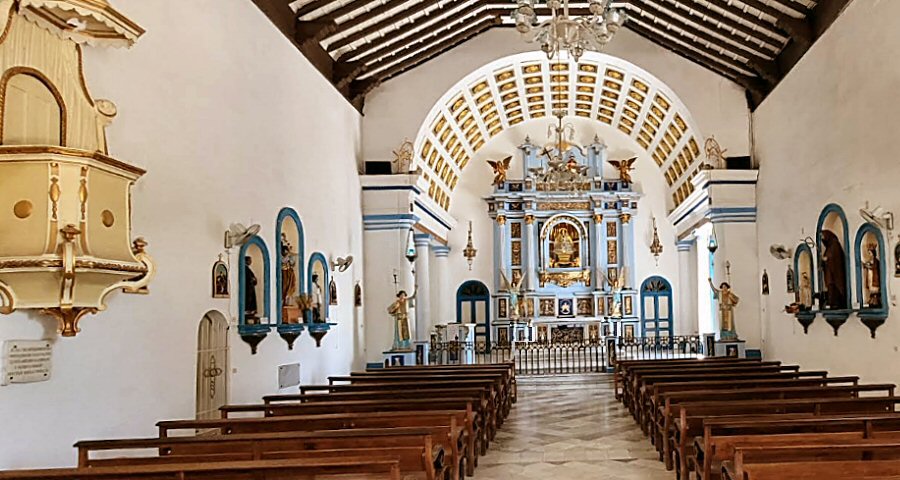
From the moment the shrine of the
Virgin of Regla was established, it became a center of
piety, and people came from the most remote places to pay
homage to her. It was first added to the
churches of Havana by order of Fray Gerónimo Valdés in 1706.
In 1708 two altars were added to the church.
On December 26, 1714, at the request of the Shrine's Chaplain, Don José Ruiz López de Salazar, to the Havana Cabildo, Our Lady of Regla was sworn in as Patron and Protector Saint of Havana Bay,
During the ceremony, amidst a crowd of regular prelates and priests, the senior councilor Marquis of Casa Torres placed a gilded silver key that symbolizes San Cristóbal de La Habana, the insignia of the Holy Arms, and the coat of arms of the city of Regla delivered to the bishop Fray Juan Lazo, who placed all the objects at the feet of the Virgin of Regla. While this was happening, countless festive demonstrations broke out: the fortresses and ships anchored in the bay fired artillery salutes, the bells rang out incessantly.
On October 29, 1717, at
the request of Mr. Gonzalo Vaquedano, who had been elected
prosecutor of the Supreme Council of the Indies, and
previously a judge of the Royal Court of Lima, and with great
celebration, the Blessed Sacrament was placed in the church
for the first time. The Mass was celebrated with great
solemnity and joy for eight days. It was undoubtedly a time
of great triumph for the sanctuary, as nothing existed in Regla at that date. There were only a few rooms to
accommodate the devotees next to the church.
The church played a significant
role in the establishment and growth of today's Regla
municipality. For example, a 70-year-old, one-eyed woman
named Zeferina obtained permission from the landowners to
build a hut near the church and sell food and cooking pots
to pilgrims who came to worship. This small-scale trade
attracted the attention of other vendors, and gradually,
shops began to open in the town.
In 1762, facing the threat of an
English invasion, the priest of Regla was forced to
personally transport the image of Our Lady of Regla and her
jewels on horseback to the Church of Calvary on the borders
of Managua (currently Arroyo Naranjo). Indeed, the English
occupied the church shortly thereafter.
The current church was completed
primarily with the help of the devotees of the Virgin in
September 1811. It was baptized by Father Gonzalo Herrera.
In 1818 the tower and the
neoclassical façade were finished, thanks to the work of the
mathematician Pedro Abad Villarreal, and the builder Don
Pedro Justiniani.

With the completion of the church
building, social life began to revive in Regla. Black women
were making sweets and other foods to sell to those who came
to the fair. Animals were killed as offerings and
distributed. Everyone participated in the community. Hosted
by the chaplain, tables were set for the devotees of Our
Lady of Regla and high-ranking officials from the city of
Havana took part in these events.
On September 7, 1817, the
renowned Cuban priest and patriot Venerable Félix Varela y
Morales preached from the church's pulpit.
On September 6, 1885, the tiled
brick vault that adorns the presbytery with 105 laminated
rosettes was inaugurated. At the time of the Parish priest
Miguel Pons y Pons, the Carrara marble floor was laid and
the staircase of the presbytery was built, in addition to
the semicircular doors with stained glass windows
representing the 4 evangelists.
On February 24, 1956 the statue
of the Virgin Mary was canonically crowned in the Holy See
Cathedral of Havana (Catedral de la Purísima Concepción de
María) by the Archbishop of Havana, His Eminence
Cardinal Manuel Arteaga y Betancourt, in the name of the
Holy Father Pius XII, who conveyed the petitions to the Holy
See made by the parish priest Ángel Pérez Varela. The Virgin
Mary's crown was made primarily from the offerings of the
Cuban people.
On August 11, 1965 the the
Sanctuary was declared a National Monument.
On July 8, 1986 the Blessed
Mother Teresa of Calcutta visited the temple on her first
visit to Cuba.
On February 24, 1987, in the year
of Regla's third centenary, the Archbishop of Havana, Msgr.
Jaime Lucas Ortega Alamino, consecrated the altar and the
church. The relics placed on the altar are those of Saint
Simplicio.
On November 30, 1987, at the request of the Archbishop of Havana, the Bishops of Cuba declared the sanctuary a National Shrine, in recognition of the devotion to the Virgin of Regla, which has spread from here throughout Cuba and is a daily center of pilgrimage.

The Iglesia de Nuestra Señora
Regla, officially Santuario Nacional de Regla, is one of the
most important buildings in Regla which is one of Havana's
15 municipalities.
The church is dedicated to the
Virgin of Regla. It should be explained here that Our Lady
of Regla, otherwise known as Our Lady of the Rule and The
Virgin of Regla, is a Marian apparition of the Catholic
Church venerated in various Hispanic countries such as:
Cuba, the Dominican Republic, Canary Islands, Mexico, and Spain. In contrast to
other Marian apparitions, she is typically depicted with
dark skin.

HISTORY
The story of the Virgin of Regla
that the inhabitants of Regla worshipped dates back to the
5th century. As in almost every place in the world, the
Virgin Mary is venerated under a specific name or devotion.
Here too, legend and history intermingle.
Saint Augustine (360-436), who
lived in the city of Hippo in northern Algeria in the 5th
century, founded the order known as the Augustinians.
Members of this order, the Augustinians, followed a Rule (Regla)
or set of norms devised by the saint himself for the proper
following of Jesus Christ. The Catholic priest, considered
one of the most prolific in literature, was a highly
cultured figure. According to legend, one day, he received a
revelation: an angel commanded that the statue of the Virgin
be carved from wood, beautifully decorated, and placed in
his oratory.
The priest then ordered the
figure of the Virgin to be carved in black, in keeping with
the complexion of the Africans. A disciple who wanted the
sanctuary rebuilt and a statue of the Virgin be worshipped
in accordance with the revelation received by St. Augustine,
accomplished this by using the finest dark cedar he could
find. Thus, a statue of the black-skinned Virgin Mary began
to be venerated in the shrine at Tagaste, St. Augustine's
birthplace.
When the Arabs invide the North
Africa and sack Tagaste, a deacon named Cypriano rescued the
statue of the Virgin Mary and, despite a powerful storm,
transported it on a small vessel across the Strait of Gibraltar to Spain. This
event is considered the first miracle of the Virgin of Regla:
Barbarian invasions were unable to defeat her. In the
following years, the tradition made the Virgin the Patron
Saint of sailors, as a result of having brought the ship
safely to the sea despite the storm. September 8, coinciding
with the Nativity of the Virgin Mary, also began to be
celebrated as the Feast of the Virgin de la Regla.
Cipriano arrived in Chipiona, a
town in Cádiz, with the statue and delivered it to the abbot
of the Convent of Hermits of San Agustín. Because Andalusia
was under the occupation of the Saracens at the time, the
statue could not occupy its deserved place on the altar in
the convent. The priest kept the statue's existence a secret
until the grave. As the statue had been skillfully hidden in
a nearby well to protect it from the Arabs, no one knew
anything about the statue for centuries.
According to another story, a
priest of the Convent of Santa María de Regla of Chipiona dreamed that a
tall, black-faced woman commanded him to go to the shores of Chipiona to rescue the narrated statue of the Virgin. The
woman told him, "Under the tree where you will rest, there
will be what you so eagerly seek." Consequently, in 1330,
the same priest found her hidden during a walk he was taking
with some farmers. The statue was hidden under the ground
next to a fig tree.
Don Joaquín Ponce de León, the
feudal lord of Chipiona, converted his castle into a
monastery for the worship of the statue. However, only the
head and body of the Virgin statue remained.
In 1590, the entire statue was
covered with a thick plate of silver, resembling armor,
leaving only the head uncovered.
It's unclear how much of what's
been said so far is true, but the earliest archive
information about the Virgin statue in question dates back
to 1365. According to this, this sculpture in Convent of
Santa María de Regla in Chipiona is carved from dark fibrous
wood, is seated, and measures 62 cm high. It is in the
Romanesque style, a typical feature of the Black Madonna.
Since the 16th century, the
Virgin have been placed on a silver frame.
During the Spanish colonization
of Cuba, slave owners attempted to impose Catholicism on
their slaves. This initiated a process of syncretism and
intercultural interaction in Cuba that continues until
today. When the believers of Yoruba entered the church, they
identified the appearance of the images they were forced to
worship with the deities of their own cult. This signified a
form of preservation of the Yoruba religion. This process
has progressed quite rapidly. The appearance of the Virgen
de la Caridad del Cobre, the patron saint of Cuba, and the
appearance of the Virgen La Regla occurred at the same time,
a little over a century after the Spanish conquest of Cuba.
On 3 March 1687, Police Chief Don Pedro Recio de Oquendo granted the land of the demolished San Pedro de Guaicanamar sugar mill and the land that he used for the cultivation of wheat to build a shrine dedicated to the Virgin of Regla. It was four caballerías of land, on a hill looking to the sea at the point called Camaco.
Manuel Antonio, who was born in
Lima/Peru and was better known by the nickname El Peregrino
(Pilgrim) , was in charge of building the first church.
Soon, El Peregrino received the necessary permission from
the ecclesiastical and secular authorities, specifically
from Bishop Diego Evelino de Compostela, to build that small
oratory with a thatched roof on the narrowest part of a
strip of land adjacent to Havana Bay. Construction was completed on
December 16, 1688, and Manuel Antonio placed an image of the
black-skinned Virgin represented by an oil painting which
was worshiped in Regla. This is the origin of this shrine
and this town.
On January 16, 1688 the oil
painting of the dark-skinned Virgin began to be worshipped
in the simple temple.
On October 24, 1692 the storm San
Rafael devastated the shrine. Fearful of the storm, Asturian
Juan de Conyedo vowed to build a chapel dedicated to the
Virgin Mary, if he would survive. After the storm was over,
On September 8, 1694, Sergeant
Major Don Pedro de Aranda y Avellaneda, nicknamed "Castellano
de la Punta", donated to the hermitage the statue of the
Virgin Mary that he had brought with him on his return from
a trip to Madrid.
every day, 08:00 - 16:00
The Iglesia de Nuestra Señora Regla is accessed via the Vía Blanca highway. To reach the Iglesia de Nuestra Señora Regla, you can prefer to take the ferry departing from Havana.
